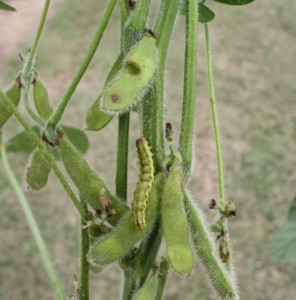Identification of PPO-resistant Palmer amaranth has been a concern for many over the past couple of weeks. I am sure many of the Palmer amaranth escapes in West Tennessee are not due to resistance. However some definitely are. We are up to 4 counties now where the Palmer amaranth with the PPO-resistant gene has been identified. So how can one tell if Palmer amaranth that escapes FlexStar, Ultra Blazer or Cobra is due to resistance or another issue? Continue reading
Category Archives: Soybean
Crop Progress
As reported by NASS on July 27, 2015
CORN AND SOYBEANS LOOK GOOD
Despite higher than normal temperatures across much of the state, crops were reported to be in mostly good to excellent condition. Between scattered showers, farmers applied herbicides to combat late season weeds. A few grain sorghum producers reported problems with worms. Rains have kept grass growing, aiding pasture conditions. Continue reading at Crop Progress 7 26 15.
Soybean pests relatively quiet

There have been only a few calls concerning soybean insect problems. Mostly what is being reported is sub-threshold infestations of stink bugs, green cloverworm, a few remaining Japanese beetles, and kudzu bugs in some areas (see previous article). As usual, we can expect things to get more active as the season progresses. Below are some things to key on. Remember that late maturing fields are generally more likley to have significant insect pests problems. Continue reading
Crop Progress
As reported by NASS on July 20, 2015
SOME CROPS STILL UNDER WATER WHILE OTHER AREAS NEED RAIN
Even though some crops are under water from previous floods in the Delta area, topsoil moisture showed a 12 percent increase in the short category statewide and subsoil moisture increased 7 percent in the same category. Even so, most crops are in good to excellent condition. Continue reading at Crop Progress 7 19 15.
Interesting Insects: Blister beetles
Occasionally, you catch a blister beetle in a sweep net sample in Tennessee soybeans. These large, showy adult beetles may also feed in clusters and defoliate the plants. Defoliation of soybeans in an area a big as a pickup truck is not a concern, but if it occurs over a large area, such as the size of a barn, treatment is warranted. Refer to PB 1768 for control options. Continue reading
Watch for kudzu bugs in soybean
This advice is primarily for those in east Tennessee and counties bordering the Mississippi and Alabama borders. The second generation flight of kudzu bugs has been active for the past couple of weeks. I’ve observed treatment level infestations in some fields in east Tennessee and in the Memphis area. It is likley that kudzu bugs have infested and are continuing to lay eggs in other soybean fields. Below are some tips for managing kudzu bugs. Continue reading
Soybean diseases and fungicide considerations
As soybean fields in Tennessee reach reproductive growth stages, scouting for disease is critical to determine how necessary a fungicide application may be in protecting yield from disease. Continue reading
Palmer Amaranth Management in 2016
There has been some discussion about how to manage Palmer amaranth next year in light of the likely PPO-resistant Palmer amaranth in the picture in some fields. Continue reading

